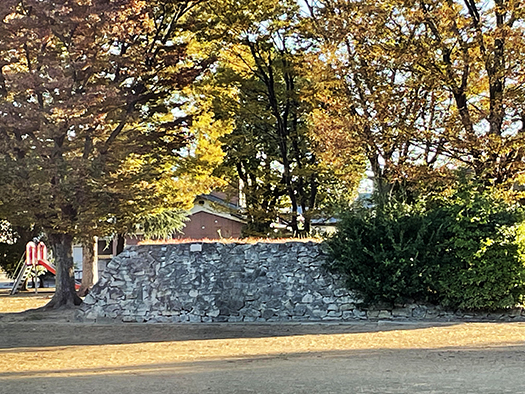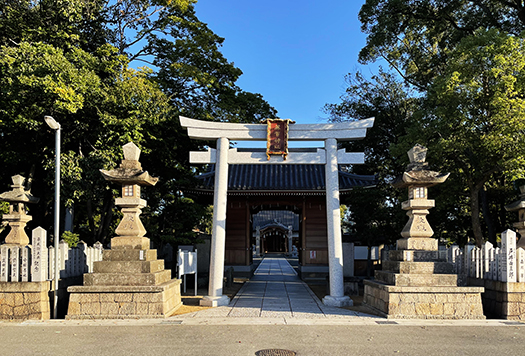

こちらには関西に出掛ける度に、可能な限りは参拝させていただいています。場所は兵庫県姫路市飾磨区英賀宮町2丁目70。WEBサイトを見ると以下のような記述も。
〜NHK大河ドラマ「軍師 官兵衛」ゆかりの地 紀行「英賀城と英賀神社」
姫路を舞台に播磨各地が登場する今年2014年のNHK大河ドラマ「軍師 官兵衛」。毎回本編のあとにその回の舞台となった官兵衛ゆかりの地が紹介される紀行に当英賀神社も英賀城とともに3月9日(日)に放送に登場します。〜
ということで、歴史的には織田家・秀吉軍によって攻められて1580年2月13日に落城して、英賀・三木家は武家勢力としては敗亡した。一応、家系伝承ではそういうルーツ認識があってその後、一族は各地に散らばって歴史年代を生きてきた、というのですね。そのルーツ伝承に従えば、わが家の家系などははるか遠隔の北海道まで流れてきたワケで、その時間の積層と流転の振幅に思いが募らざるを得ません。
ことし自分の環境も一変したのでこれからはも、こうした探索を深めたいと思っています。写真上は英賀神社のすぐ近くの公園に遺されている「石垣」と英賀神社の正面写真。数年前、コロナ禍と並行して神社の改修工事が行われていたのですが、その令和の大改修も無事、終わったようでした。

で、わたしの歴史好きを決定的にしてくれた司馬遼太郎さんの「播磨灘物語」の石碑も境内に建てられています。「播磨灘物語」のあとがきで司馬さんが自身のルーツにふれた件があり、そこでは司馬さんの家、本姓は「福田」さんですが、かれの家系はこの英賀城で家老のような立場で戦った家系だと言うこと。
この攻城戦では「落城当日の戦死者は、本城のみで千二百三十七名を数え、城郭、社寺、城下町はすべて兵火により灰燼に帰した」とされている。まことに死生にも関わった縁が深いのかもと、その文章を読んで司馬さんへの敬愛・親近感がさらに強まった記憶があります。碑文の揮毫は司馬遼太郎さんのもの。
こういった「歴史情報センター」機能を地域の神社というのは果たしているのでしょう。もちろんこうしたことは「伝承」であって、事実そのものかどうかはもっと解明して行かないとわからない。そうではあるけれど、人間は血脈のなかで「生かされている」存在であることも事実。科学的な探究とともに先人の足跡を探ることも、やはり自然な心情ではあるだろうと思います。先人が残したこうした情報センターは貴重。
今回はたまたま宮司さんともお話しさせていただけましたが、かれも英賀城に縁のある方とお話しされていられました。たしかにルーツ探しでは科学的解明は難しいけれど、いろいろな「符合」が重なってもくるもので、そういう瞬間に出会うのも一種の醍醐味だと思えます。
English version⬇
[Mysteriously at the “Aga Shrine,” a clue in the search for my roots…
The historical “information centers” such as shrines that have been bequeathed to Honshu as a family lineage that has flowed to Hokkaido are gratifying and valuable. Inquire about the true nature of the life that has kept you alive. The “Aga Shrine” is a shrine that has been preserved in Honshu.
Every time I go to Kansai, I visit this place as much as possible. The location is 2-70 Eiga-miya-cho, Shikama-ku, Himeji City, Hyogo Prefecture.
〜The NHK historical drama “Gunshi Kanbei” “Eiga Castle and Eiga Shrine” (in Japanese)
The 2014 NHK Taiga Drama “Gunshi Kanbei” is set in Himeji and features various areas in Harima. The “Eiga Shrine” and Aga Castle will appear on the air on March 9 (Sun.) as part of a travelogue that introduces the places associated with Kanbei after each episode. 〜The broadcast will be aired on Sunday, March 9.
The Aga Miki family lost the castle on February 13, 1580, after it was attacked by the Oda and Hideyoshi forces. In a manner of speaking, you say that the family tradition recognizes such roots and that after that, the family scattered to various places and lived through the historical ages. If this is correct, then my family lineage has drifted as far away as Hokkaido, and I can’t help but think about the time lapse and the amplitude of change.
My environment has changed drastically this year, and I would like to continue to deepen my search in this way. The photo above is a front view of the Aga Shrine and the “stone wall” that remains in the park near the shrine. Several years ago, the shrine was undergoing renovation work in parallel with the Corona disaster, and the major renovation of the shrine in 2025 seemed to have been successfully completed.
The monument to Ryotaro Shiba’s “Harimanada Monogatari” (The Tale of Harimanada), which made my love for history definitive, is also erected in the precincts of the temple. In the afterword of “Harimanada Monogatari”, Mr. Shiba mentions his roots, and says that his family, whose real name is “Fukuda”, fought at Eiga Castle as a retainer.
It is said that “the death toll on the day of the siege was 1,237 in the main castle alone, and the castle walls, shrines and temples, and the castle town were all reduced to ashes by the fire. I remember that my respect and affinity for Mr. Shiba was further strengthened when I read that sentence, thinking that he may indeed have had a close connection with death and life. The inscription was written by Ryotaro Shiba.
Local shrines probably fulfill the function of a “historical information center” in this way. Of course, these things are “folklore,” and whether or not they are facts themselves will not be known until they are further clarified. It is true, however, that human beings are “kept alive” in our blood. I think it is a natural sentiment to search for the footprints of our predecessors as well as scientific inquiry. Such information centers left by our predecessors are valuable.
This time, I also happened to have a chance to talk with the chief priest of the shrine, who also had a connection to Eiga Castle. It is true that it is difficult to find the roots scientifically, but there are many coincidences, and it is a real pleasure to encounter such moments.
Posted on 11月 10th, 2023 by 三木 奎吾
Filed under: 日本社会・文化研究, 歴史探訪







コメントを投稿
「※誹謗中傷や、悪意のある書き込み、営利目的などのコメントを防ぐために、投稿された全てのコメントは一時的に保留されますのでご了承ください。」
You must be logged in to post a comment.